The 1993 N.N. Vohra Committee report warned that criminal syndicates—nurtured and protected by politicians, police officials, and sections of the bureaucracy—had entrenched themselves so deeply that they were running a parallel system of governance in several parts of India.
The committee studied how gangs amassed wealth through illicit activities such as land-grabs and extortion, then bought muscle and political influence, blurring the line between state and organised crime.
This ought to be seen against the recent spate of police encounter killings in different parts of India, including Uttar Pradesh (256 since 2017), Punjab (at least five this year), and Tamil Nadu (at least 21 since 2021).
The police shootout in Delhi’s Rohini neighbourhood on October 23 was the latest of these extra-judicial methods of “ending” crime. Four of Bihar’s most wanted gangsters lay dead.
The slain men, allegedly contract killers led by 25-year-old Ranjan Pathak, who entered the world of crime at 19, were part of the notorious “Sigma and Company” gang that had spread terror across Bihar’s Sitamarhi district in recent months.
Intelligence intercepts indicated they were plotting “high-profile hits” ahead of the upcoming Bihar Assembly election, prompting the police to act swiftly.
The Rohini encounter, and the spate of encounters in other States, are symptoms of a deep, entrenched nexus between crime and politics.
Police celebrate the elimination of what they term “hardened criminals”, but uncomfortable questions linger. How did a band of 20-something contract killers gain enough power to potentially disrupt a State election? Who enabled their rise, and why was an extra-judicial shootout needed to stop them?
The answers point to a reality where gangsters and strongmen become integral to a State’s political landscape, thriving in an ecosystem of weak governance, political patronage, and public acquiescence.
Symptoms of this larger malaise are visible in the form of police encounters in States such as Uttar Pradesh, where extra-judicial killings are paraded as proof of decisive leadership.
What is troubling, however, is that such methods are seeping into States historically associated with better governance traditions, such as Tamil Nadu, suggesting that the corrosion of constitutional norms is neither regional nor partisan but systemic.
Nexus and impunity
Gangsters cannot thrive without powerful patrons. In Bihar and Uttar Pradesh, decades of evidence show an active nexus where ruling politicians shield criminals in exchange for money and muscle during elections.
Also Read | ‘Encounter Pradesh’ model of instant justice indicates terror may become state policy
The case of Vikas Dubey, a Uttar Pradesh gangster who at his peak had 60 cases including murders, exemplified this dynamic. He was so emboldened by political protection that in 2001 he murdered a BJP State Minister, Santosh Shukla, inside a police station in broad daylight. Such was his clout that not one of the 25 policemen eyewitnesses dared testify against him in court.

Gangster Vikas Dubey, the main accused in the killing of eight policemen in the Kanpur encounter in July 2020, was arrested from Ujjain in Madhya Pradesh after a nearly week-long chase involving the police across three States.
| Photo Credit:
PTI
For years, Dubey and his family won local elections and enjoyed cutting deals with parties across the spectrum, from the Bahujan Samaj Party to the BJP. Without political backing, no criminal is audacious enough to carry out such acts.
In cases like Dubey’s, the path to justice in a court of law is routinely subverted. Witnesses turn hostile; in Dubey’s case, even the investigating officer turned hostile and developed sudden amnesia. Prosecutions collapse under such circumstances.
Years later, the accused emerges from legal limbo, often more powerful than before. Courts become helpless in such situations.
Even when a conviction is secured, usually after a change in the political winds, the punishment may not stick.
In April 2023, Bihar’s Nitish Kumar government provoked outrage because it tweaked the State’s Bihar Prison Manual, 2012, to make murder convict Anand Mohan eligible to apply for remission. The move was nakedly political, just a year before the 2024 general election: Singh commands a large following among Rajputs, a key voter bloc.
Although Mohan is not a “gangster” in that sense, the incident highlights the extent to which political patronage comes to criminals’ aid.
Lesser-known gangsters, perhaps like the Sigma Gang, often function as enforcers for politicians during elections: intimidating voters, capturing booths in remote pockets, or attacking opponents. In return, they expect protection.
As several retired Indian Police Service officers have stated on record, once they grow in size and strength, it becomes difficult for State authorities to manage them.
Police officers who try to take on these networks without political backing do so at grave risk: some have been murdered or falsely implicated in retaliatory cases. It is not unheard of for police officers to be handpicked by local dons, ensuring friendly cops in their strongholds.
The net effect is a breakdown of the rule of law.
The double-edged sword
When the State finally does move against gangsters, either because they are no longer of use to the nexus or because of a change in the political regime, they are discarded in public spectacles such as police encounters—outside the ambit of law.
The midnight encounter that felled Pathak’s gang is a case in point: swift and decisive, but entirely bypassing the courts. Officials maintain the operation was clean, that the suspects opened fire first and lethal force was the only option. This is the same script repeated in every encounter incident.
However, if one takes a closer look at the official story—as this author did in an August 2024 investigative report on Uttar Pradesh’s encounter killings for New Lines Magazine—it hardly withstands scrutiny.
Every one of these cases officially follows the same script: the “dreaded criminal” or “hardened criminal” attacked or tried to flee, police fired in self-defence, end of story. Rarely does it go to trial or detailed, impartial investigation.
The State’s own forensic examination report, ballistic reports, and other scientific documents, along with witness testimonies and a careful connect-the-dots exercise would expose how most of these police encounters would turn out to be staged, cold-blooded murders by the police—far from their claim of a “spontaneous encounter”.

Special Task Force and Forensic teams re-enact the events leading to the encounter of gangster Vikas Dubey, as part of an ongoing investigation of the case, in Kanpur district, on July 18, 2020.
| Photo Credit:
PTI
Gangster Dubey’s death in July 2020, when he was being transported after being arrested in connection with eight policemen’s deaths, was a staged execution to silence him before he could expose his nexus with police and politicians. The police stated that the police van carrying him overturned after meeting an accident and that he attempted to escape and was shot dead in the process—an extremely doubtful story.
Despite these regular, staged encounters, no meaningful accountability has followed. The National Human Rights Commission (NHRC) and courts intervene in only a handful of the most egregious cases, and even then, justice moves slowly.
Police across States resort to extra-judicial executions of alleged criminals, touting them as triumphs of justice served, especially when public anger is high after a heinous crime.
Yet each such extra-judicial execution amounts to a vote of no confidence by the State in its own criminal justice system and governance.
The normalisation—or even co-opting encounters as an official State policy on policing—has led to this mechanism becoming a source of revenue for pockets of policemen.
An India Today investigation in the early days of Yogi Adityanath’s government exposed rate cards floated by his policemen for knocking off someone.
Since then, Uttar Pradesh has averaged five encounters per day. By the State’s own admission, 256 “hardened criminals” were shot dead in over 15,000 police encounters between 2017 and October this year, and over 10,324 others were injured in “half-encounters” as termed locally, usually a bullet in the kneecap aimed at disabling them. 31,960 criminals have been arrested in the process.
As this author’s experience reporting in Uttar Pradesh has shown, most of those killed by the police were either involved in petty crimes or had enmities with powerful men, usually of different caste, in their vicinities.
This, against the backdrop of a deeply criminalised society, where the line between state power and private enmity is porous, and where the justice system’s failures are exploited by both the police and local elites to settle scores through state-sanctioned violence.
The Court’s attempt
The Supreme Court laid down guidelines in the People’s Union for Civil Liberties case of 2014 to curb fake encounters: requiring every police shooting to be independently investigated by a separate State agency, a magisterial inquiry completed within three months, and prompt reporting to the NHRC within 24 hours. On paper, these seem robust safeguards.
However, in practice, they are routinely ignored or subverted, partly because of the ambiguous language within the Court’s guidelines.
Although the 2014 PUCL guidelines state that a first information report must be lodged after every case of encounter death, it does not explicitly state against whom.
The police then use this loophole to lodge an FIR against the deceased, stating that they attempted to murder its officers. Given that the accused is dead, a closure report is filed in the court, which accepts it without questions.
Political leaders, for their part, often reward officers who rack up encounter kills, hailing them as heroes of public safety, as Adityanath has done and as Bombay’s history is witness.

An India Today investigation in the early days of Yogi Adityanath’s government exposed rate cards floated by his policemen for knocking off someone.
| Photo Credit:
PTI
Such “encounter specialists” in some States have even been given gallantry medals and promotions—a perverse incentive structure that virtually encourages extra-judicial executions.
The Supreme Court has failed both to resolve the ambiguity within its 2014 guidelines and to act tersely against the spate of encounter killings.
This presents a troubling paradox: in regions plagued by gangsterism, the public often applauds these instant “encounter justice” incidents.
When the four Sigma gang members were killed in Delhi, many might have breathed a sigh of relief that these thugs would no longer haunt their streets or the upcoming election.
It is hard to entirely blame the public’s sentiment. Frustrated by decades of lax policing and sluggish courts, many see encounters as short-cut to safety: better a dead gangster than one who escapes justice via bribes or intimidation.
The encounter culture is essentially a mirror image of the gangster culture: it operates on the principle that ‘might makes right’—that the State can suspend law to eliminate those who flout it—a state of exception.
In doing so, however, the State inadvertently validates the gangster’s own creed of vigilante justice. After all, if the police can act as judge, jury, and executioner when expedient, it reinforces the notion that due process is dispensable if politically expedient. This sets a dangerous precedent.
Who draws the line between a “justified encounter” and a murder? Every encounter is essentially a confession of the State’s failure—a failure to build a case, a failure to secure a conviction, and failure to uphold law in a courtroom instead of a roadside ditch.
It may eliminate one gangster, but it leaves the systemic rot untouched. What about the big fish? This author’s reporting in Uttar Pradesh revealed how bigger mafias sit safe in many parts of the State, untouched by a trigger-happy police mechanism.
Democracy at gunpoint
The cost of this gangster-politician nexus is borne by ordinary people. It is seen in empty lanes after dark in crime-ridden towns, in the extra “insurance money” businesses must pay to local toughs, in the young talent that flees the State for safer pastures.
It is also borne by the integrity of institutions. The police, for instance, swing between politicisation and demoralisation: expected to be either complicit with reigning strongmen or risk their careers or lives confronting them.
The judiciary reels under a backlog of cases stretching into decades, and when a don is actually convicted against all odds, it makes news precisely because it is so rare.
Is there a way out of this morass? The problem is multi-dimensional and demands intervention on every front: from reducing pendency in courts and tightening bail norms for habitual offenders to instituting a credible witness protection system and long-delayed police reforms. Prison reforms too.
Also Read | Encounter killings and the strongman phenomenon
It requires investment in education and employment for the young, a stronger and truly independent NHRC, and above all, a cultural shift—a collective recognition that state-sponsored killings are not justice, and that impunity is not strength.
Yet all these efforts are undercut, time and again, by the spectacle of encounters that promise instant justice while corroding the very foundations of the rule of law.
Is there political will at all to address this multi-fold problem? The Supreme Court has made it clear that the right to life is fundamental, and even a dreaded criminal has the right to be judged in accordance with the law.
A State that shortcuts that process only loses moral authority and cedes the high ground to the very criminals it seeks to eradicate.
Saurav Das is an investigative journalist writing on law, judiciary, crime, and policy.


